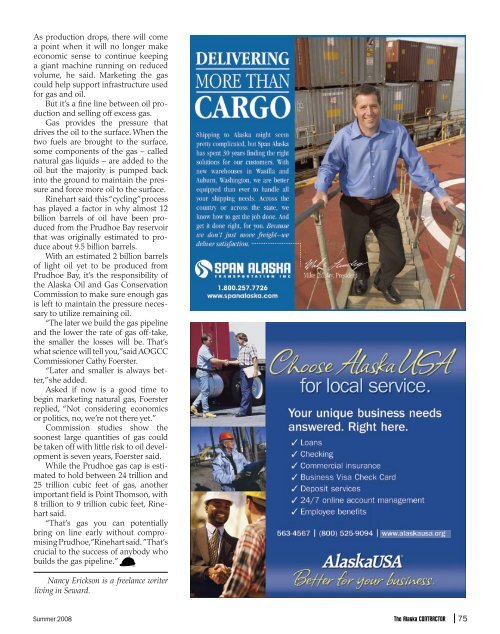The Alaska Contractor - Summer 2008
The Alaska Contractor - Summer 2008
The Alaska Contractor - Summer 2008
You also want an ePaper? Increase the reach of your titles
YUMPU automatically turns print PDFs into web optimized ePapers that Google loves.
As production drops, there will come<br />
a point when it will no longer make<br />
economic sense to continue keeping<br />
a giant machine running on reduced<br />
volume, he said. Marketing the gas<br />
could help support infrastructure used<br />
for gas and oil.<br />
But it’s a fine line between oil production<br />
and selling off excess gas.<br />
Gas provides the pressure that<br />
drives the oil to the surface. When the<br />
two fuels are brought to the surface,<br />
some components of the gas – called<br />
natural gas liquids – are added to the<br />
oil but the majority is pumped back<br />
into the ground to maintain the pressure<br />
and force more oil to the surface.<br />
Rinehart said this “cycling” process<br />
has played a factor in why almost 12<br />
billion barrels of oil have been produced<br />
from the Prudhoe Bay reservoir<br />
that was originally estimated to produce<br />
about 9.5 billion barrels.<br />
With an estimated 2 billion barrels<br />
of light oil yet to be produced from<br />
Prudhoe Bay, it’s the responsibility of<br />
the <strong>Alaska</strong> Oil and Gas Conservation<br />
Commission to make sure enough gas<br />
is left to maintain the pressure necessary<br />
to utilize remaining oil.<br />
“<strong>The</strong> later we build the gas pipeline<br />
and the lower the rate of gas off-take,<br />
the smaller the losses will be. That’s<br />
what science will tell you,” said AOGCC<br />
Commissioner Cathy Foerster.<br />
“Later and smaller is always better,”<br />
she added.<br />
Asked if now is a good time to<br />
begin marketing natural gas, Foerster<br />
replied, “Not considering economics<br />
or politics, no, we’re not there yet.”<br />
Commission studies show the<br />
soonest large quantities of gas could<br />
be taken off with little risk to oil development<br />
is seven years, Foerster said.<br />
While the Prudhoe gas cap is estimated<br />
to hold between 24 trillion and<br />
25 trillion cubic feet of gas, another<br />
important field is Point Thomson, with<br />
8 trillion to 9 trillion cubic feet, Rinehart<br />
said.<br />
“That’s gas you can potentially<br />
bring on line early without compromising<br />
Prudhoe,” Rinehart said. ”That’s<br />
crucial to the success of anybody who<br />
builds the gas pipeline.”<br />
Nancy Erickson is a freelance writer<br />
living in Seward.
















